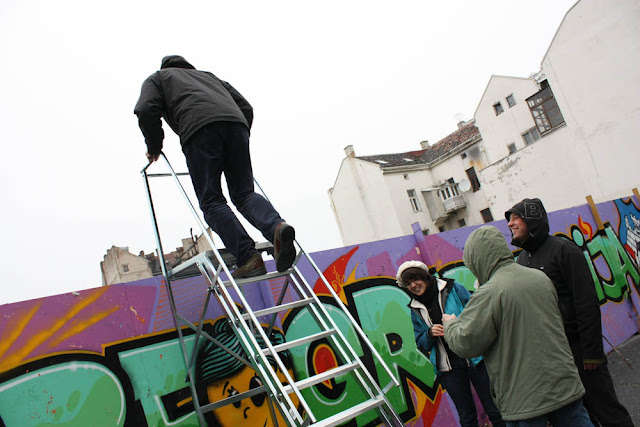http://blog.goethe.de/goethe-guerilla/index.php?/archives/41-Pogled-preko-plota.html
Šta bi na tom mestu zapravo trebalo da bude, i ko bi o tome trebalo da odlučuje ostavljamo građanima na razmatranje. Njihova zapažanja i predloge stavićemo u bocu, a zatim ćemo istu pustiti niz reku, u nadi da će je neko sa druge strane sveta pronaći.
Građevinsko-megalomanska idila Beograda
Muzej, zgrada fakulteta, stanica podzemne železnice, arheološki park, hotel, tržni centar, igralište za decu, teren za fudbal, otvoreni bazen, skejt park – bile su samo neke od želja prolaznika koji su na inicijativu Goethe – Gerile zavirili iza ograde gradilišta u ulici Kralja Petra (stara okretnica trola) i tamo otkrili zjapeću rupu. Usled višegodišnje izloženosti vremenskim uslovima rupa se napunila vodom a u toku proleća bila je i stanište za patke. Šta bi na tom mestu zapravo trebalo da bude, i ko bi o tome trebalo da odlučuje ostavljamo građanima na razmatranje. Njihova zapažanja i predloge stavićemo u bocu, a zatim ćemo istu pustiti niz reku, u nadi da će je neko sa druge strane sveta pronaći.
Construction and megalomaniacal idyll Belgrade
Museum, University of buildings, subway stations, an archaeological park, hotel, shopping center, a playground for children, football pitch, swimming pool, skate park - there were just some of the tell passers-by on the initiative of the Goethe - Guerrillas glimpse behind the fences at construction sites Kralja Petra (old turntable trolley) and there discovered gaping hole. Due to years of exposure to weather conditions, holes were filled with water in the spring was also a habitat for ducks.
What would this place really should be, and who would be on that decision is left to the citizens for their consideration. Their observations and suggestions will put in a bottle, and then we let the same down the river in hopes someone from the other side of the world to find.
Museum, University of buildings, subway stations, an archaeological park, hotel, shopping center, a playground for children, football pitch, swimming pool, skate park - there were just some of the tell passers-by on the initiative of the Goethe - Guerrillas glimpse behind the fences at construction sites Kralja Petra (old turntable trolley) and there discovered gaping hole. Due to years of exposure to weather conditions, holes were filled with water in the spring was also a habitat for ducks.
What would this place really should be, and who would be on that decision is left to the citizens for their consideration. Their observations and suggestions will put in a bottle, and then we let the same down the river in hopes someone from the other side of the world to find.



































































